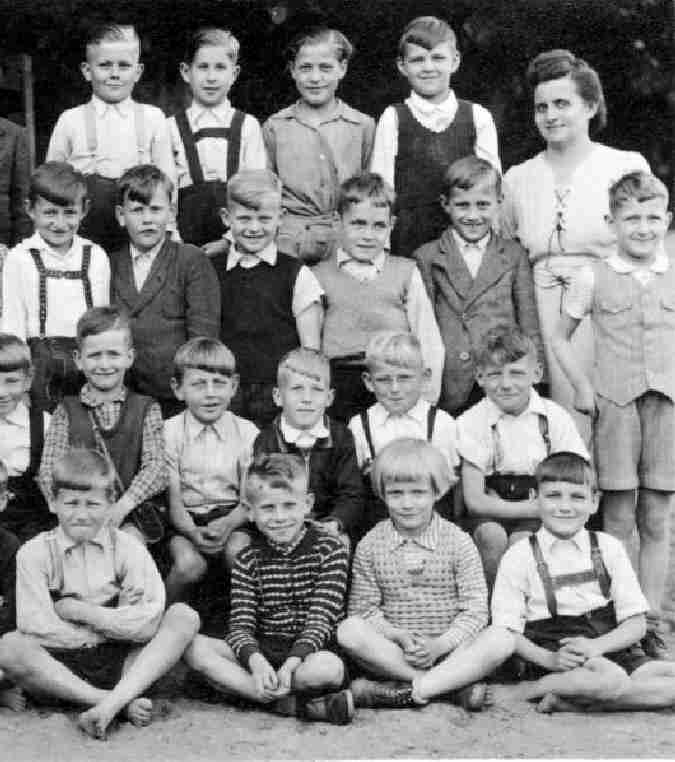
NAZI Occupation of Poland: Schools (1939-45)

Figure 1.--This photograph shows a class at the Oliwie school in 1944. We were suprised to see such healthy and well-dressed children in Poland during 1944. Emense battles were raging in Poland at the time. We suspect that Oliwie was in the areas of Western Poland annexed by the Reich. It appears to have been close to Danzig (modern Gdansk). The children may be either German children or Polish children in the process of being Germanized. Click on the image for an assessment of the school
|
This photograph shows a class at the Oliwie school in 1944. We were suprised to see such healthy and well-dressed children in Poland during 1944. Emense battles were raging in Poland at the time. We suspect that Oliwie was in the areas of Western Poland annexed by the Reich. It appears to have been close to Danzig (modern Gdansk). The children may be either German children or Polish children in the process of being Germanized.
Image Assessment
A German reader tells us, "I suppose that the name of the location is (in German) “Oliva”. Oliva was since 1926 a suburb of Danzig (Gdansk in Polish), but is much older, e.g., with a church founded in 1128 in a cloister which is the oldest brick building in this area of central Europe; there was a peace treaty in 1660 agreed in Oliva ending a war between Sweden and Poland. Danzig was one of the “Hanse-Städte” (Hansiaic cities) with rich merchants, populated by Germans. The area around is a very good agricultural area. Thus, I don´t think that there was a food shortage during the war. And clothes for children were available, homemade or taken over from elder siblings etc. Some of the clothes look to be a little small, no shoes. Well, it was wartime, of course. If my supposition is correct this is an image of a German class there. The children look very German, not Polish.
The NAZI objective in Poland was to destroy the Polish nation and Polish nationalism. The long term objectives was to substantially reduced the Slavic population in Poland and other areas of Eastern Europe. Some were to be killed, others deported, and the remainder converted into slave labor for menial tasks. The enormity of these
terrifying plans would have far eclipsed the Jewish Holocaust. These national and racial policies of course affected the NAZI
approach to education. The NAZIs in the areas of Poland annexed to the Reich was total "Germanization". This policy was was most rigorously executed in western annexed territories which the Germans called Wartheland.
Oliva School
We do not have any information on the Oliva school seen here other than the photograph. It is clearly a primary school. And it was located near Danzig. Danzig itself was heavily populated by Germans as well as suburbs. There were more Poles in the syrrounding countryside. Many iof the Poles were expelled by the NAZIs after the World War II invasion (September 1939). Thus the children here were either Germans or Poles who the NAZIs had qualified for Germinization.
Danzig
As our German reader mentions, Danzig was an important Hanseatic League City. After World war I, Danzig was made a free city and was the port used by Poland, which becase of East Prussia was land locked. Poland was given a corridor through the former German Empire which allowed access to Danzig and the Baltic. The Polish corridor was poulated by both Germans and Poles, as it was land obtained by Prussia in the 18th century Polish Patitions. Hitler made the Polish corridor a major issue in his speeches. After obtain the Syudetenland at the Munich Cnference (Seotember 1938) and then occupying the rest of Czrchoslovakia (March 1939), Hitler turned on Poland and demanded Danzig and the Polish Corridor. The first shots of World War II were fired on DAnzig by a German battleship.
World War II (1944)
Huge battles were fought in Poland during 1944 when this [hotograph was taken as the Red Army moved West. The German Army Grup Central was devestated in Operation Bragatton (June 1944) which permitted the Soviets to move into Poland proper. This Soviet offensive was timed to make it impossible for the NAZIs to repond effectively with the D-Day landings in France (June 1944). The Red Army paused before Warsaw, in part to allow the Germans to desroy the (anti-Communist) Home Army. By the end of the year the Red Army controlled Poland and was on the Oder River, poised for the final assault on Berlin.
Only a few months after this photograph was taken, these children would have been refugees. Millions of Germans were on the roads pouring west, terrified of the Red Army. Some were aware of what Germany had done in the East and feared retribution. Others were terrified because of NAZI propaganda broadcasts describing Soviet barbarity. Many Germans had lived in areas of East Prussia and Poland for centuries and wanted to stay on their land. There were massive attriocities inflicted on Germans both by the Red Army as well as Poles seeking revenge. Germans who attempted to stay were forcibly deported after the War by the Polish Government. This operation was conducted with cinsiderable brutality. What we have less information about is what happened to the Poles who tried to Germanize during the NAZI occupation.
HBC

Navigate the Boys' Historical Clothing Web Site:
[Return to Main NAZI occupation of Poland page]
[Return to Main World War II displaced children page]
[Introduction]
[Activities]
[Biographies]
[Chronology]
[Clothing styles]
[Countries]
[Bibliographies]
[Contributions]
[FAQs]
[Glossaries]
[Satellite sites]
[Tools]
[Boys' Clothing Home]
Created: 8:21 PM 9/17/2004
Last updated: 10:21 PM 9/22/2004



